Disassembly
The washed and cleaned engine is installed on a stand for disassembly and oil is drained from the crankcase.
Remove hose 1 (pic. 22) and hose 2 of the crankcase ventilation system; remove the hoses 4 and 7, respectively, for supplying and discharging liquid from the cooling system to the carburetor and the vacuum extraction tube 8 to the vacuum regulator of the ignition distributor sensor. Remove carburetor 3 with spacer 5 and heat shield 6.
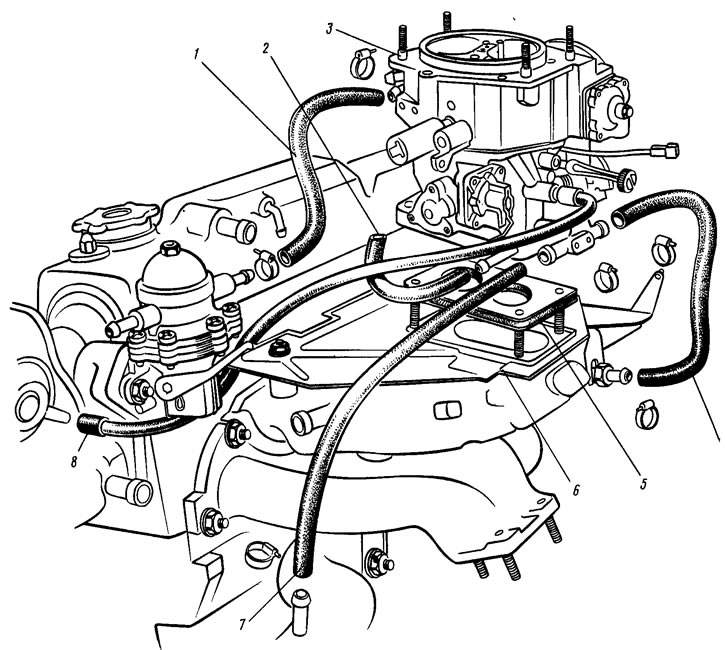
Pic. 22. Dismantling the engine - removing the carburetor
Remove the high voltage wires and the ignition distribution sensor 1 (pic. 23) with sealing ring 3 and bracket 2. Remove fuel pump 8 with heat-insulating spacer 6, pusher 7 and gaskets. Remove the housing 4 of the auxiliary units with the sealing ring 5.

Pic. 23. Engine disassembly - removal of the fuel pump and ignition distributor sensor
Remove tension bar 1 (pic. 24) and belt 4 of the generator drive 2. Remove the generator and the bracket 3 of its fastening. Block the flywheel with a retainer 67.7820.9526 (see fig. 29), unscrew the pulley mounting bolt 5 (see fig. 24) generator drive and remove the pulley.
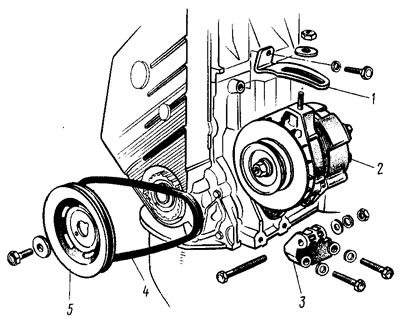
Pic. 24. Dismantling the engine - removing the generator and pulley
Remove front cover 1 (pic. 25) toothed belt with a rubber seal 2. Unscrew the nut securing the tension mechanism. Loosen and remove the toothed belt 3. Remove the tension roller 6 with the axis 7 and the spacer ring 5. Holding the camshaft pulley 4 from turning with fixture 67.7811.9509 or another by the pulley holes, unscrew the mounting bolt and remove the pulley. Remove the toothed pulley 8 from the crankshaft of the engine.
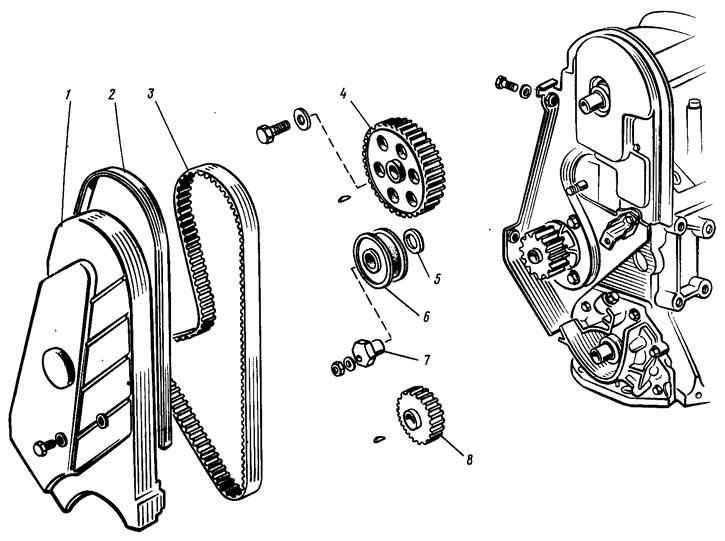
Pic. 25. Dismantling the engine - removing the camshaft drive
Loosen pump mounting bolts 2 (pic. 26) coolant. Unscrew the bolt and nut securing the rear cover 1 of the toothed belt and remove it.
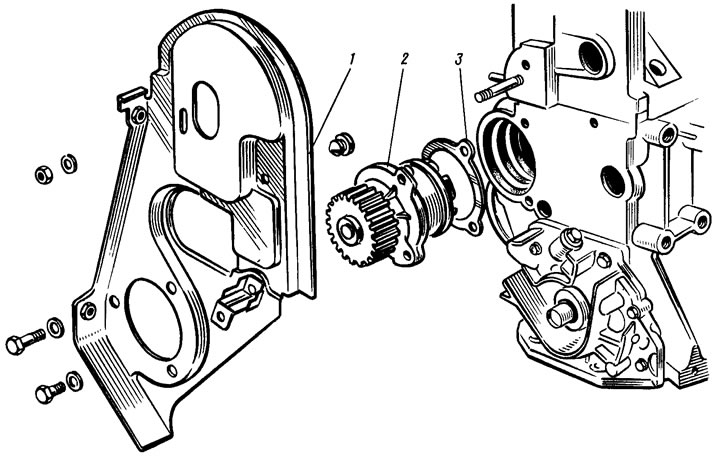
Pic. 26. Engine disassembly - coolant pump removal
Remove the coolant pump with gasket 3 from its socket in the cylinder block.
Remove the intake and exhaust pipes with gaskets, warm air intake and coolant pump inlet pipe bracket. Remove the oil pressure warning light sensor from the cylinder head. If a complete disassembly of the engine is not required, then you can remove the cylinder head assembly with pipelines and auxiliary units.
Remove the coolant inlet and outlet hoses to the heater. Disconnect the hoses from the thermostat and remove it. Remove the inlet pipe of the coolant pump and the outlet pipe of the cooling jacket with the gasket. Key 67.7812.9514 (tubular face 21 mm) unscrew the coolant temperature indicator sensor and spark plugs.
Device A.60312 (pic. 27) remove the oil filter with gasket. Disconnect the crankcase exhaust ventilation hose from the nozzles on the head and cylinder block. Take out the oil level indicator.
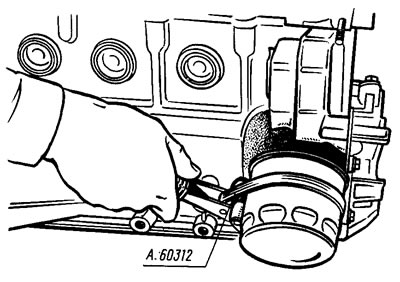
Pic. 27. Removing the oil filter
Remove the cylinder head cover. Unscrew the mounting bolts and remove the cylinder head assembly with the camshaft. If necessary, disassemble the cylinder head (see «Dismantling and assembly of a head of cylinders»).
Turn the engine over with the crankcase up and remove the oil sump 5 (pic. 28) with gasket 4. Remove the oil receiver 3 and oil pump 1 with gasket 2. Unscrew the nuts of the connecting rod bolts, remove the connecting rod covers and carefully remove the pistons with connecting rods through the cylinders.
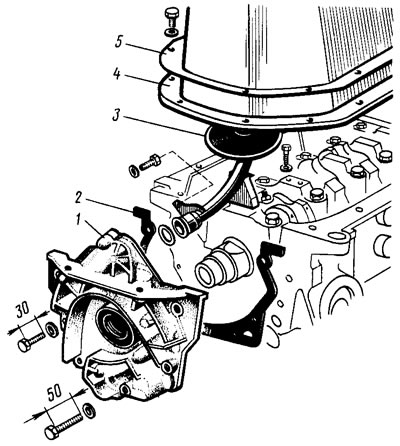
Pic. 28. Engine disassembly - oil pump removal
Block the flywheel with a retainer 67.7820.9526 (pic. 29), unscrew the flywheel mounting bolts, remove the washer (ring) bolts and flywheel from the crankshaft. Remove the main bearing caps along with the lower bearings. The crankshaft is removed from the bearing seats, and then the upper shells and thrust half rings from the middle support.
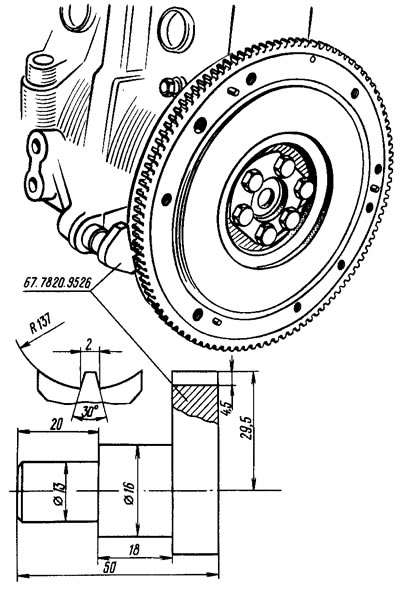
Pic. 29. Locking the flywheel with a latch
Assembly
The washed and cleaned cylinder block is installed on the stand and the missing studs are wrapped. Install the alternator mounting bracket and secure it with two bolts.
Lubricate the bearing shells and thrust half rings of the crankshaft, as well as pistons and oil seals, with engine oil. When assembling the engine after repair, new crankshaft oil seals are installed. Install the liners in the sockets and caps of the main bearings. The crankshaft is laid in the main bearings and thrust semi-rings are inserted into the seats of the middle main bearing with grooves (on this side there is an anti-friction layer) towards the thrust surfaces of the crankshaft.
Install the main bearing caps according to the marks (pic. thirty). Lids must be positioned so that the marks (or the side with the most marks) located on the generator side. Tighten the cover bolts.
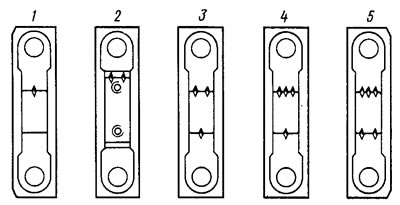
Pic. 30. Marks on the main bearing caps (the number of marks corresponds to the bearing number)
Check the axial play of the crankshaft. To do this, turn the cylinder block back up (pic. 31) and install a stand with an indicator on it so that the indicator leg rests against the crankshaft flange. Moving the shaft with screwdrivers as levers up and down, measure the axial play with an indicator. It should be 0.06-0.26 mm. If the play is greater, then it is brought back to normal by installing thrust half-rings with a thickness increased by 0.127 mm.
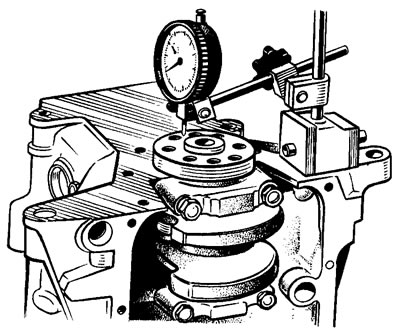
Pic. 31. Checking the axial free play of the crankshaft
Mandrel 67.7853.9571 * is pressed into the holder of the rear oil seal of the crankshaft. Put the holder with the stuffing box on the conical mandrel 67.7853.9572 ** and move it from the mandrel to the crankshaft flange. Install a gasket under the holder and attach it to the cylinder block with bolts with spring washers.
* Cylindrical mandrel Ø 106 mm with guide collar Ø 78 mm.
** Cup with an outer diameter of 80 mm and a 15°cone.
Install the flywheel on the crankshaft so that the mark (cone-shaped hole) near the rim was against the axis of the connecting rod journal of the 4th cylinder. Install the washer and flywheel mounting bolts. Block the flywheel with a retainer 67.7820.9526 (see fig. 29) and tighten the mounting bolts.
The pistons are selected to the cylinders so that the gap between the piston and the cylinder is 0.025-0.045 mm. On a new engine, this is achieved by installing pistons of the same class as the cylinders. Used engines have some wear on pistons and cylinders. Therefore, it is necessary to re-select the pistons to the cylinders, measuring their diameter (see sect. «Device Features» in the same chapter), so that the gap is as close as possible to the calculated one.
Assemble pistons with connecting rods (see below «Disassembly and assembly of the connecting rod and piston group»). Using the bushing from the kit A.60604, pistons with connecting rods are inserted into the cylinders (pic. 32). The kit includes bushings of normal and repair sizes of pistons. Therefore, it is necessary to select a bushing suitable for the size of the piston to be installed.
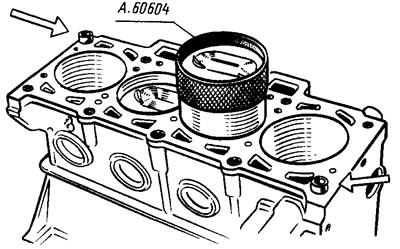
Pic. 32. Installation of the piston with piston rings in the cylinder using the mounting sleeve from the kit A.60604. The arrows indicate the bushings for centering the head on the cylinder block
You can also use the adjustable sleeve 67.7854.9517. The pin hole on the piston is offset by 1.2 mm, so when installing the pistons in the cylinders, the arrow on the piston crown must point towards the camshaft drive.
Install the bearings in the connecting rods and connecting rod caps. Connect the connecting rods to the crankshaft journals, install the covers and tighten the connecting rod bolts. Connecting rod caps must be installed so that the cylinder number on the cap is opposite the cylinder number on the bottom end of the connecting rod.
Using a mandrel 67.7853.9580, the front crankshaft oil seal is pressed into the oil pump cover until it stops. Pour some engine oil into the pump and turn the drive gear several times. Insert the mandrel guide bushing 67.7853.9580 into the stuffing box pressed into the oil pump, and turn the drive gear to a position where it could be put on the crankshaft journal. Move the pump from the guide sleeve to the shaft, install a gasket under the pump and attach it to the cylinder block.
For proper installation, two guide pins are pressed into the pump housing, which must fit into the corresponding holes in the cylinder block.
Insert an oil receiver with an o-ring into the hole of the oil pump, attach it to the oil pump and to the cover of the second main bearing of the crankshaft (see fig. 28).
Install the oil sump with gasket and secure it. Lubricate the oil filter O-ring with engine oil and install the oil filter by manually screwing it to the fitting on the cylinder block.
Insert two centering bushes into the cylinder block (see fig. 32) and install a new cylinder head gasket on them (used gasket must not be used). Before installing the gaskets, oil is removed from the mating surfaces of the head and cylinder block. The gasket must be clean and dry. Oil must not be allowed to come into contact with the gasket surface. Install the cylinder head assembled in accordance with the instructions in Sec. «Dismantling and assembly of a head of cylinders».
Check the length of the cylinder head bolts (without bolt head). If the length of the bolts is more than 135.5 mm, then replace them with new ones. The cylinder head bolts are tightened in sequence to ensure a good seal and to prevent bolt re-tightening during maintenance (see fig. 18) and in four doses (see sect. «Removal and installation of a head of cylinders»).
The coolant pump with gasket is inserted into the socket of the cylinder block, checking the reliability of pressing the pump pulley onto the roller (see «Dismantling and assembly of the pump of a cooling liquid»). Install the rear toothed belt cover and attach it together with the pump cover to the cylinder block. Additionally, attach the cover with a bolt to the cylinder block and a nut to the stud on the cylinder head.
Segmented keys are inserted into the sockets at the front ends of the crankshaft and camshaft and toothed pulleys are installed. Holding the camshaft pulley from turning with tool 67.7811.9509, fix the pulley with a bolt with a washer. Turn the camshaft pulley until the mark on the pulley aligns with the installation barb on the rear toothed belt protective cover (see fig. 6).
Turn the crankshaft in the direction of a smaller angle of rotation until the alignment mark on the pulley aligns with the mark on the oil pump cover. You can turn the crankshaft with a key for a bolt temporarily wrapped in the front end of the shaft, or for the flywheel.
Install the tension roller with the axle and the spacer ring and fix it in the position corresponding to the minimum belt tension.
They put a toothed belt on the crankshaft pulley and, pulling both branches of the belt, put the left branch on the coolant pump pulley and wind it behind the tension roller. Put the belt on the camshaft pulley and slightly tighten it with the tension roller, turning the roller axis counterclockwise. When installing the belt, do not allow it to sharp bends.
Turn the crankshaft two turns in the direction of rotation and check that the alignment marks match (see fig. 6).
If the marks do not match, then loosen the belt tension, remove it from the camshaft pulley, turn the pulley to the required angle, put on the belt, slightly tighten it with a tension roller, turn the crankshaft again two turns and check the matching marks.
If the marks match, adjust the belt tension and the clearances in the valve mechanism, as indicated in Sec. «Engine settings». Install the front timing belt cover and secure it with bolts. Carefully place the gasket in the groove of the cylinder head cover around the entire perimeter. Install the cover on the cylinder head, put rubber bushings on the studs and bait the nuts with washers. If the bushings have signs of destruction, then replace them with new ones. The nuts are tightened evenly in several steps until the washer rests on the stud. It must be remembered that the tightness of the cover depends on the thoroughness of all operations for its installation.
Spark plugs, coolant temperature gauge and oil pressure warning lamps are wrapped in the cylinder head.
Install the outlet pipe 3 on the cylinder head (pic. 33) cooling jackets with a gasket and secure it with two nuts. Install the gasket and attach the flange of the supply pipe 1 of the coolant pump to the cylinder block. The hoses going to the thermostat are put on the branch pipe and the supply pipe, thermostat 2 is installed and the hoses are fixed with clamps.
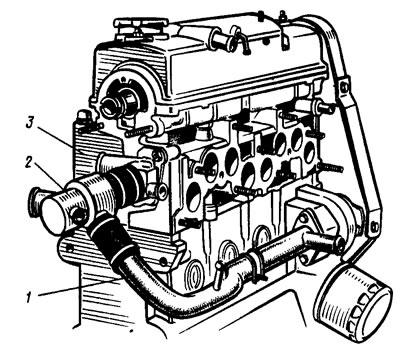
Pic. 33. Installation of elements of the cooling system
Install the housing of auxiliary units with a sealing ring on the cylinder head and fix it with a bolt. When installing the housing, special attention is paid to the position of the sealing ring in the groove, since when the nuts are tightened, it may jump out of the groove and bite between the edges of the groove and the surface of the cylinder head. If the sealing ring has signs of biting, then it must be replaced with a new one. Install the fuel pump with a heat-insulating spacer, with gaskets and a pusher (see sect. «Removal and installation of the fuel pump») .
Lubricate with engine oil and put on the sealing ring on the flange of the ignition distributor sensor and attach it to the auxiliary unit housing in such a position that the average risk on the distributor sensor flange is against the mounting protrusion on the auxiliary unit housing (pic. 34). At the same time, a bracket for high voltage wires is installed under the upper fastening nut. The roller of the sensor-distributor is connected to the camshaft shank in only one position. Therefore, before installation, turn the roller so that the cams of the roller clutch enter the grooves of the camshaft shank.
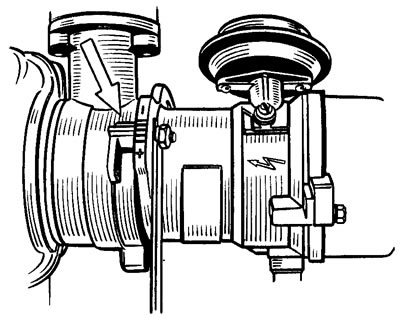
Pic. 34. Installation of the sensor-distributor ignition. The arrow shows the mounting ledge on the body of auxiliary units
Put gaskets on the cylinder head studs, install the exhaust manifold 1 (pic. 35) and tighten the central nut of its fastening. Then, the inlet pipeline 3 is installed together with the warm air intake 4 and the bracket 2 of the coolant pump inlet pipe and fixed with nuts. Install the crankcase exhaust ventilation hose and fix it with clamps on the branch pipes of the block and cylinder head. Install an oil level indicator.
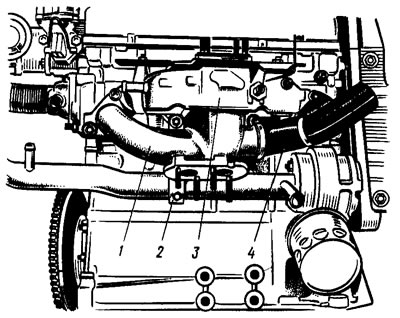
Pic. 35. Installing the intake pipe and exhaust manifold
Put the alternator drive pulley on the crankshaft and fix it with a bolt and washer. Install tension bar 1 (see fig. 24) and a generator. Put the belt on the pulleys of the crankshaft and generator and adjust its tension, as described in Sec. «Engine settings».
Install the carburetor heat shield, spacer and carburetor. Fix it with nuts and close it with a technological plug from above. Do not tighten nuts or secure a hot carburetor.
Install the gasoline supply hose from the fuel pump to the carburetor and secure it with clamps. Install a vacuum sampling tube to the vacuum regulator, as well as hoses for supplying and discharging liquid from the cooling system to the carburetor.
Install the hoses leading to the heater on the outlet pipe of the cylinder head and on the inlet pipe of the coolant pump and fix them with clamps. Connect the high voltage wires to the distribution sensor and spark plugs. Fix the wire comb in the bracket 2 (see fig. 23). Pour oil into the engine through the neck on the cylinder head cover.
